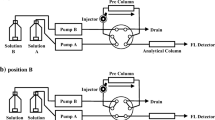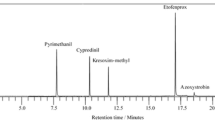Abstract
In the present work a sensitive and accurate method by ion chromatography and conductimetric detection has been developed for the determination of biogenic amines in food samples at microgram per kilogram levels. The optimized extraction procedure of trimethylamine, triethylamine, putrescine, cadaverine, histamine, agmatine, spermidine, and spermine from real samples, as well as the separation conditions based on a multilinear gradient elution with methanesulfonic acid and the use of a weak ionic exchange column, have provided excellent results in terms of resolution and separation efficiency. Extended calibration curves (up to 200 mg/kg, r > 0.9995) were obtained for all the analyzed compounds. The method gave detection limits in the range 23–65 μg/kg and quantification limits in spiked blank real samples in the range 65–198 μg/kg. Recovery values ranged from 82 to 103 %, and for all amines, a good repeatability was obtained with precision levels in the range 0.03–0.32 % (n = 4). The feasibility and potential of the method were tested by the analysis of real samples, such as tinned tuna fish, anchovies, cheese, wine, olives, and salami.

IEC‐CD multiresidual method for accurate determinations of biogenic amines in foodstuffs


Similar content being viewed by others
References
European Commission (2005) European Commission regulation (EC) no. 2073/2005, Off. J. Eur. Union L338 1-26
Balamatsia CC, Paleologos EK, Kontominas MG, Savvaidis IN (2006) Correlation between microbial flora, sensory changes and biogenic amines formation in fresh chicken meat stored aerobically or under modified atmosphere packaging at 4 °C: possible role of biogenic amines as spoilage indicators. Anton Leeuw 89:9–17
Chan ST, Yao MWY, Wong YC, Wong T, Mok CS, Sin DWM (2006) Evaluation of chemical indicators for monitoring freshness of food and determination of volatile amines in fish by headspace solid-phase microextraction and gas chromatography–mass spectrometry. Eur Food Res Technol 224:67–74
Galgano F, Favati F, Bonadio M, Lorusso V, Romano P (2009) Role of biogenic amines as index of freshness in beef meat packed with different biopolymeric materials. Food Res Int 42:1147–1152
Tasić T, Ikonić P, Mandić A, Jokanović M, Tomović V, Savatić S, Petrović L (2012) Biogenic amines content in traditional dry fermented sausage Petrovská klobása as possible indicator of good manufacturing practice. Food Control 23:107–112
Krizek M, Pavlicek T, Vacha F (2002) Formation of selected biogenic amines in carp meat. J Sci Food Agr 82:1088–1093
Silva CMG, GloriaMB A (2002) Bioactive amines in chicken breast and thigh after slaughter and during storage at 4 +/-1 °C and in chicken-based meat products. Food Chem 78:241–248
Loret S, Deloyer P, Dandrifosse G (2005) Levels of biogenic amines as a measure of the quality of the beer fermentation process: data from Belgian samples. Food Chem 89:519–525
Adhoum N, Monser L, Sadok S, El-Abed A, Greenway GM, Uglow RF (2003) Flow injection potentiometric detection of trimethylamine in seafood using tungsten oxide electrode. Anal Chim Acta 478:53–58
Vinci G, Antonelli ML (2002) Biogenic amines: quality index of freshness in red and white meat. Food Control 13:519–524
Halász A, Baráth A, Simon-Sarkadi L, Holzapfel W (1994) Biogenic amines and their production by microorganisms in food. Trends Food Sci Tech 5:42–49
Kalač P, Krausová P (2005) A review of dietary polyamines: formation, implications for growth and health and occurrence in foods. Food Chem 90:219–230
Önal A (2007) A review: current analytical methods for the determination of biogenic amines in foods. Food Chem 103:1475–1486
Pena-Gallego A, Hernández-Orte P, Cacho J, Ferreira V (2009) Biogenic amine determination in wines using solid-phase extraction: a comparative study. J Chromatogr A 1216:3398–3401
Triki M, Jiménez-Colmenero F, Herrero AM, Ruiz-Capillas C (2012) Optimisation of a chromatographic procedure for determining biogenic amine concentrations in meat and meat products employing a cation-exchange column with a post-column system. Food Chem 130:1066–1073
Calbiani F, Careri M, Elviri L, Mangia A, Pistara L, Zagnoni I (2005) Rapid assay for analyzing biogenic amines in cheese: matrix solid-phase dispersion followed by liquid chromatography-electrospray-tandem mass spectrometry. J Agr Food Chem 53(10):3779–3783
Charles AL (1996) Recent advances in ion chromatography: a perspective. J Chromatogr A 739:3–13
Johnson DC, LaCourse WR (1990) LC with pulsed ECD at gold and platinum. Anal Chem 62:589A–597A
Draisci R, Cavalli S, Lucentini L, Stacchini A (1993) Ion exchange separation and pulsed amperometric detection for determination of biogenic amines in fish products. Chromatographia 35(9/12):584–590
Johnson DC, Hoekstra JC (1998) Comparison of potential-time waveforms for the detection of biogenic amines in complex mixtures following their separation by liquid chromatography. Anal Chem 70:83–88
De Borba BM, Rohrer JS (2007) Determination of biogenic amines in alcoholic beverages by ion chromatography with suppressed conductivity detection and integrated pulsed amperometric detection. J Chromatogr A 1155:22–30
Rey M, Pohl C (2003) Novel cation-exchange column for the separation of hydrophobic and/or polyvalent amines. J Chromatogr A 997:199–206
Cinquina AL, Calì A, Longo F, De Santis L, Severoni A, Abballe F (2004) Determination of biogenic amines in fish tissues by ion-exchange chromatography with conductivity detection. J Chomatogr A 1032:73–77
Casella IG, Palladino GA, Contursi M (2008) Determination of aliphatic amines by cationexchange chromatography with suppressed conductivity detection after solid phase extraction. J Sep Sci 31:3718–3726
Favaro G, Pastore P, Saccani G, Cavalli S (2007) Determination of biogenic amines in fresh and processed meat by ion chromatography and integrated pulsed amperometric detection on Au electrode. Food Chem 105:1652–1658
Saccani G, Tanzi E, Pastore P, Cavalli S, Rey M (2005) Determination of biogenic amines in fresh and processed meat by suppressed ion chromatography-mass spectrometry using a cation-exchange column. J Chromatogr A 1082:43–50
Draisci R, Giannetti L, Boria P, Lucentini L, Palleschi L, Cavalli S (1998) Improved ion chromatography-integrated pulsed amperometric detection method for the evaluation of biogenic-amines in food of vegetable or animal origin and in fermented foods. J Chromatogr A 798(1–2):109–116
Arlorio M, Coïsson JD, Martelli A (1999) Extraction methods for biogenic amines in wine and beer. Ita J Food Sci 11(4):355–360
European Commission (2002) European Commission decision 2002/657/EC, Off. J. Eur. Union L221, 8
European Commission (2004) European Commission regulation (EC) no. 882/2004 of 29 April 2004 Off. J. European Union, L165, pp. 1–141
Self RL, Wu WH, Marks HS (2011) Simultaneous quantification of eight biogenic amine compounds in tuna by matrix solid-phase dispersion followed by HPLC-orbitrap mass spectrometry. J Agric Food Chem 59(11):5906–5913
Sagratini G, Fernández-Franzón M, De Berardinis F, Font G, Vittori S, Mañes (2012) Simultaneous determination of eight underivatised biogenic amines in fish by solid phase extraction and liquid chromatography–tandem mass spectrometry. J Food Chem 132:537–543
Ndagijimana M, Belletti N, Gardini F, Vernocchi P, Lanciotti R, Patrignani F (2012) Biogenic amines and ethyl carbamate in primitivo wine: survey of their concentrations in commercial products and relationship with the use of malolactic starter. J Food Protect 75(3):591–596
Yamanaka H, Shiomi K, Kikuchi T (1987) Agmatine as a potential index for freshness of common squid (Todarodes pacificus). J Food Sci 52:936–938
Kawabata T, Ohshima H, Ino M (1978) Occurrence of methylguanidine and agmatine in foods. IARC Sci Publ 19:415–423
Acknowledgments
Ministero della Salute (Rome, Italy) is thanked for providing financial support.
Author information
Authors and Affiliations
Corresponding author
Additional information
Published in the special issue Analytical Science in Italy with guest editor Aldo Roda.
Rights and permissions
About this article
Cite this article
Palermo, C., Muscarella, M., Nardiello, D. et al. A multiresidual method based on ion-exchange chromatography with conductivity detection for the determination of biogenic amines in food and beverages. Anal Bioanal Chem 405, 1015–1023 (2013). https://doi.org/10.1007/s00216-012-6439-z
Received:
Revised:
Accepted:
Published:
Issue Date:
DOI: https://doi.org/10.1007/s00216-012-6439-z




